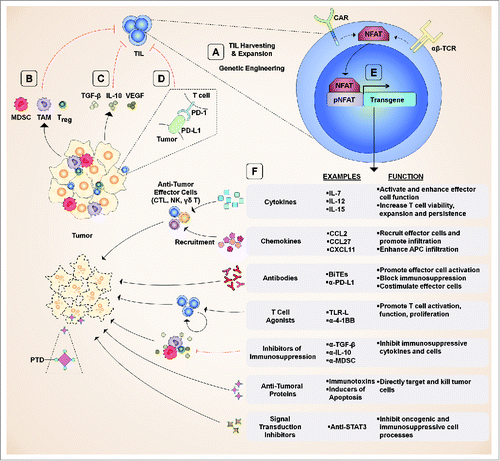Figures & data
Figure 1. Schematic of possible T cell vehicle biologics and their therapeutic targets. (A) TIL are isolated from tumors, expanded, and can be genetically engineered using a wide variety of transgenes. (B) Immunosuppressive cells generate a tumor microenvironment conducive to tumor cell growth which limits T cell function. (C) Immunosuppressive cytokines and bioactive molecules suppress T cell function. (D) Immune checkpoints are activated by interactions between T cells, tumor cells, and other cells of the tumor microenvironment and suppress effector cell function. (E) Transgenes can be designed with promotors allowing antigen-dependent expression. (F) A wide variety of transgene products can be selected for various purposes. Abbreviations: APC, antigen presenting cell; BiTE, bi-specific T-cell engager; CAR, chimeric antigen receptor; CTL, cytotoxic T lymphocyte; MDSC, myeloid-derived suppressive cell; NFAT, nuclear factor of activated T-cells; NK, natural killer; PD-1, programmed death-1; PD-L1, programmed death ligand 1; pNFAT, NFAT-responsive promoter; PTD, protein transduction domain; TAM, tumor-associated macrophage; TCR, T cell receptor; TGF-β, transforming growth factor β; TIL, tumor infiltrating lymphocyte; Treg, regulatory T cell; VEGF, vascular endothelial growth factor;.

Table 1. Advantages of producer T cells.
Table 2. Literature review on producer T cells.
Table 3. Limitations and challenges of producer T cells.
